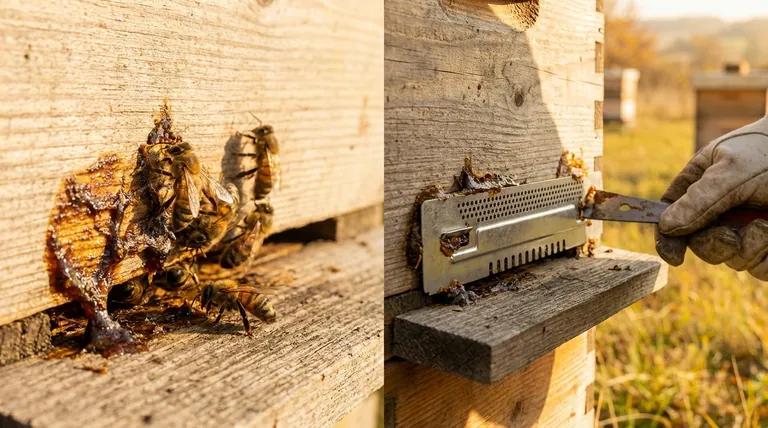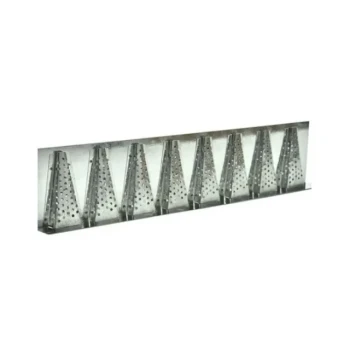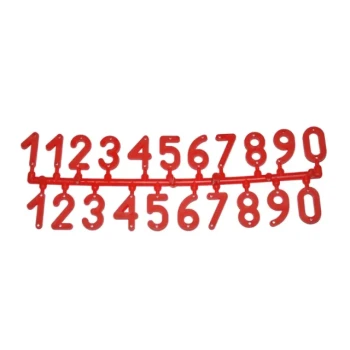The vast majority of honey bee colonies have the genetic ability to reduce their hive entrance using a substance called propolis. This behavior is a fundamental part of their strategy for controlling the hive's internal environment and defending the colony, especially in preparation for the winter months.
Understanding the bees' natural instinct to seal their hive is the first step. The second is recognizing when your intervention with a man-made entrance reducer is necessary to ensure the colony's survival and security.

The Purpose of a Reduced Entrance
A hive's entrance is its most vulnerable point. Managing its size is critical for the colony's success, addressing two primary concerns: climate control and defense.
Temperature and Humidity Control
A smaller entrance makes it significantly easier for the bee cluster to maintain the stable temperature and humidity required to survive the winter. It minimizes heat loss and reduces cold drafts that can stress or kill the colony.
Defense Against Intruders
A large, undefended entrance is an open invitation to predators and thieves. A smaller opening is easier for the guard bees to patrol and protect against mice seeking warmth, as well as robbing bees, wasps, and hornets looking to steal honey.
The Bees' Natural Solution: Propolis
When left to their own devices, bees are not passive. They actively modify their home using a unique, self-produced material.
What is Propolis?
Propolis, often called "bee glue," is a resinous mixture that honey bees produce by combining their own saliva and beeswax with exudates gathered from tree buds, sap flows, or other botanical sources.
How Bees Use It to Modify the Entrance
Bees use this sticky, antimicrobial substance to seal unwanted gaps and cracks in the hive. As autumn progresses, many colonies will instinctively begin applying propolis around the edges of their entrance to shrink it to a more defensible and climate-appropriate size.
Understanding the Trade-offs: When to Intervene
While the bees' use of propolis is effective, you cannot always rely on it exclusively. A beekeeper's primary role is to observe and intervene when nature isn't enough.
When Natural Behavior Falls Short
Not all colonies will reduce their entrance sufficiently, especially by late autumn when it becomes critical. Younger colonies or those with less pronounced genetic tendencies for propolizing may leave the entrance wide open, making them highly vulnerable.
The Role of an Entrance Reducer
An entrance reducer is a simple wooden or plastic block designed to fit into the hive's bottom entrance. It typically has two different-sized notches, allowing the beekeeper to set the opening to a small size for winter or a medium size for protection against robbing during other seasons.
Benefits Beyond Winter
Using an entrance reducer is not just a winter tool. It provides a reliable mouse guard and offers year-round protection against robbing, which can decimate a weak colony in a matter of hours. It is a simple and highly effective piece of security equipment.
Making the Right Choice for Your Hive
Your decision to intervene should be based on observation and your primary management goal for the colony.
- If your primary focus is supporting natural behavior: Observe your hive in late autumn. If the bees are actively reducing the entrance with propolis, you may not need to act. Only intervene if they fail to secure the hive by the time cold weather arrives.
- If your primary focus is proactive defense: Use an entrance reducer on its medium or small setting for young or weak colonies year-round. This is the best way to prevent robbing from other bees and wasps.
- If your primary focus is successful wintering: Install an entrance reducer with the smallest opening by late autumn, regardless of propolis activity. This is the most reliable method to protect the colony from cold drafts and prevent mice from nesting inside.
By understanding the interplay between natural instinct and practical tools, you can make the best decision to ensure your colony thrives.
Summary Table:
| Situation | Bees' Natural Action | Beekeeper's Intervention |
|---|---|---|
| Late Autumn / Winter Prep | May seal entrance with propolis | Use entrance reducer if sealing is insufficient |
| Weak or Young Colony | May not reduce entrance adequately | Use entrance reducer year-round for defense |
| Defense Against Robbing | Guard bees patrol a smaller opening | Use entrance reducer to create a defensible choke point |
| Mouse Prevention | Propolis can deter entry | Entrance reducer acts as a reliable mouse guard |
Secure Your Apiary's Success with HONESTBEE
Your colonies' winter survival hinges on proper entrance management. While bees have a natural instinct, a reliable entrance reducer is essential for proactive beekeeping. HONESTBEE supplies durable, precision-crafted entrance reducers and other essential beekeeping supplies to commercial apiaries and equipment distributors through our wholesale-focused operations.
We understand the critical balance between supporting natural behaviors and ensuring colony security. Our products are designed to provide that reliable protection, helping your bees—and your business—thrive.
Contact HONESTBEE today to discuss your wholesale needs and ensure your hives are equipped for success.
Visual Guide

Related Products
- Beehive Entrance Reducer Guardian Metal Hive Entrance for Bees
- Steel Round Disc Entrance Reducer for Flexzion Bee Hive Nuc Box Gate
- Multi-Functional Sliding Hive Entrance for Beekeeping
- Multi-Functional Rotary Hive Entrance Disc for Beekeeping
- Professional Reversible Beehive Hive Entrance
People Also Ask
- What size is the entrance hole in a native bee hive? The 13mm Standard for a Thriving Colony
- What are the different entrance sizes for an 8 or 10-frame Langstroth hive? A Guide to Seasonal Management
- What are the two functions of the Entrance Reducer? Master Hive Defense and Safe Transport
- What should be done after transferring frames to the new hive? Essential Steps for a Secure Colony
- How big should a beehive entrance be? Optimize for Colony Health & Honey Production



















